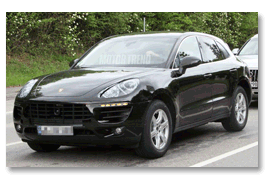Both of these design traits might constrict cargo room — not that a Porsche Macan buyer will be overly concerned with that. The taillights on this prototype are clearly stickers resembling the lights on the larger Cayenne; that trick could be a disguise designed to hide skinny LED taillights like those seen on the new 911 sports car.

The Porsche Macan will be based on the chassis of the Audi Q5 crossover, and will probably adopt that model’s engines: a turbocharged 2.0-liter inline-four and a supercharged 3.0-liter V-6 are the most likely candidates. There’s a possibility we will eventually see a range-topping Macan Turbo S with a new Porsche-developed, twin-turbo V-6 good for around 350 hp.
Expect the driveline to use some variation of Audi’s Quattro all-wheel drive system, while the chassis will likely have upgrades like optional carbon-ceramic brakes, adjustable suspension, and sportier exhaust notes. Porsche has already invested the equivalent of $691 million to prepare its Leipzig, Germany, plant to build the Macan, so expect the automaker to pull out all the stops to make it a success.
Porsche executives tell us the Macan is designed to target a new group of customers, primarily young urban buyers. The company is especially interested in what it calls the “B-SUV” segment because it sees a huge potential for growth in that category. Given that the larger Cayenne SUV now accounts for nearly half of Porsche’s annual sales volume, we can expect the more affordable Macan to similarly boost the brand’s sales numbers. The Porsche Macan also will be a clear competitor to the Land Rover Range Rover Evoque, which is likewise offered as a two- and four-door crossover.
Porsche has previously confirmed the Macan goes into production in late 2013, and has promised the model will be sold in the U.S.
Read more:
Click Here